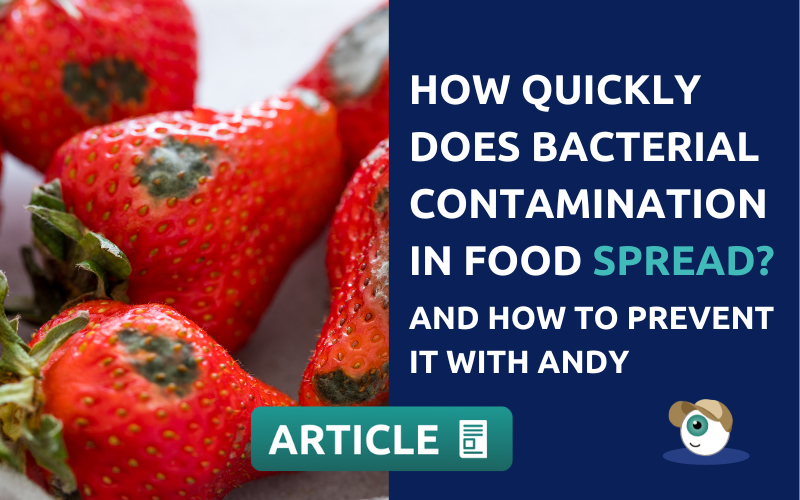How quickly does bacterial contamination in food spread and how to prevent It?

If one thing has become clear after the pandemic, it’s the ability of microorganisms to wreak “havoc” in the human body.
Fortunately, sectors like the hospitality industry have shown tremendous capacity to learn from unexpected situations and adapt to the “new normal” that now requires us to live with the looming presence of the Coronavirus.
However, it’s important to keep something in mind:
According to the WHO, 420,000 people die each year worldwide from consuming unsafe foods containing various bacteria, viruses, parasites, or harmful chemicals.
Undoubtedly, these are far too many individuals affected by bacterial contamination in food, a number that the Andy team would like to see reduced to zero.
That’s why we want to continue supporting the tremendous awareness efforts regarding food safety and traceability taking place in our restaurants with our digital food safety assistant, Andy!
As an owner of one or multiple food businesses, or as a manager, kitchen supervisor, operations lead, quality controller, etc., you can contribute to protecting public health and your customers by preventing bacterial food contamination.
And Andy App is there to support you at every step.
What is bacterial contamination of food?
Bacterial contamination is a type of biological contamination where bacteria are inadvertently introduced into food materials, causing them to spoil.
The presence of bacteria can lead to foodborne illnesses among consumers, especially vulnerable groups like pregnant women, children, the elderly, and individuals with autoimmune diseases.
In terms of food safety, the term “foodborne diseases” is often used.
When reporting an outbreak, if the causative agent hasn’t been identified yet, the term “foodborne disease” should be used, as it can be caused by bacteria or viruses (infection) or bacterial-origin toxins (intoxication).
There are two main types of biological contamination: food poisoning and foodborne infection.
Food Poisoning
Food poisoning is microbial contamination caused by bacteria that can rapidly multiply in food and produce bacterial toxins that lead to illnesses.
It’s usually caused by bacteria like Staphylococcus aureus, Clostridium perfringens, and Bacillus cereus, commonly associated with poultry meat products, low-acid canned foods, and starchy foods like rice.
Symptoms of food poisoning include stomach discomfort, nausea, vomiting, and diarrhea. Naturally, the severity of symptoms in the affected individual depends on the level of food contamination.
Foodborne Infection
Unlike food poisoning, foodborne infection is caused by the bacteria themselves and doesn’t involve toxin production.
These bacteria can cause illnesses by multiplying in food and being consumed by our customers.
Bacteria that can cause foodborne infections include Salmonella, Listeria, and Shigella.
Can you detect when food is contaminated?
Bacterial contamination of food can result in noticeable changes in contaminated ingredients, such as:
- Unpleasant odor
- Acid production leading to food souring
- Softening of the food
- Visible bubbles
- Curdling in beverages like milk
- Formation of slime on the food’s surface
However, it’s important to note that not all spoiled foods will immediately display obvious signs.
How quickly can bacterial contamination in food occur?
It depends on various factors, including the environment in which bacteria reproduce, the type of contaminating bacteria, bacterial load, and the food material.
But generally, it’s important to remember that bacteria can double their numbers very rapidly, usually every 4 to 20 minutes.
In other words, bacterial contamination of food can occur at unsafe levels within 20 minutes to a day.
The initial bacterial load in food materials can dictate the rate of deterioration, especially in the temperature danger zone, which ranges from 4°C to 60°C.
How long does it take for food to become contaminated?
Food spoilage can occur within the first 2 hours.
Pathogen transmission can happen through contact within around 20 minutes, either by coming into contact with previously contaminated food or any non-disinfected surface that has touched contaminated food, or if that surface remains in conditions conducive to bacterial growth.
How quickly can bacteria multiply under optimal conditions?
Very quickly!
Under optimal conditions, bacteria can double their numbers every 10 to 20 minutes.
This means that if a bacterium starts with 2 cells:
- After two minutes, you’ll have 4 cells.
- 16 cells in an hour.
- And so forth.
How can bacterial growth in food be prevented?
It’s undeniable that food and bacteria will always go hand in hand.
However, as food handlers, what we can do is control their presence and ensure our environments are as safe as possible for producing food without any risks for our customers.
This is where Andy App plays a crucial role.
Andy helps you protect your consumers by facilitating your tasks related to food safety control, traceability, temperatures, HACCP, hygiene, expiry date labeling, etc.
With Andy, you can track products within the restaurant or foodservice business, and understand their attributes, treatments received, and the circumstances they’ve been exposed to.
Andy enables you to develop a traceability plan that allows you to generate records containing all the necessary information for the identification and tracking (backward and forward traceability) of produced or sold products.
How does Andy App help you mange food safety?
Andy App is already assisting tens of thousands of employees worldwide with their food safety processes:
Food Labelling
Label products and ingredients faster and with enhanced food safety. Prevent errors, automate expiration date calculations, and ensure food traceability.
Digital HACCP
Digitise your cleaning and hygiene records, maintenance logs, temperatures, and any checklist compliance. Guide your team and ensure procedures are carried out in accordance with the law.
Incidents
Automate incident reporting with corrective action plans. Resolve non-conformities faster and instantly know the response in your establishments thanks to notifications.
Audits
Initiate audits with customisable scores. Control access and gather all inspections in one place.
And a lot more!
Protecting your customers from the effects of bacterial contamination in food is much simpler with Andy.
Try Andy App now and discover the many benefits of having this helpful Food Safety digital assistant in your kitchens!
👉🏽START 100% FREE HERE!👈🏽

